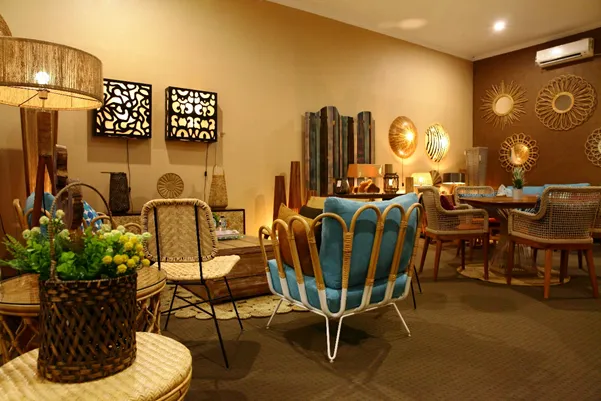A Glimpse Into Indonesia’s Rattan Heritage
Indonesia has long been celebrated as the world’s largest producer and exporter of natural rattan. The archipelago’s humid, tropical climate combined with its expansive rainforests provides the ideal environment for rattan to thrive. For centuries, local artisans have woven rattan into both utilitarian and decorative pieces, transforming a wild vine into a globally admired material.
The story of Indonesian rattan is one of nature meeting craftsmanship. Long before mass production and mechanized weaving, villagers in regions like Cirebon, Kalimantan, and Sulawesi harvested wild rattan and skillfully turned it into furniture, baskets, and household essentials. This legacy continues to influence global interior design trends that emphasize sustainability, natural materials, and timeless craftsmanship.
What makes Indonesia truly unique in the rattan world is the combination of abundant raw materials and unmatched artisanal expertise passed down through generations. Rattan has always been more than just a furniture material in Indonesia—it represents a way of life.
Natural vs Synthetic and Why Indonesia Leads
Rattan is a climbing palm vine that grows abundantly in Indonesia’s tropical forests. Unlike wood, which requires cutting down entire trees, rattan vines regenerate quickly and are harvested without causing deforestation. This eco-friendliness makes it a highly sustainable material and one of the reasons why global buyers increasingly prefer Indonesian rattan furniture.
There are more than 300 species of rattan in the world, and over 50 of them are native to Indonesia. Each species has unique characteristics, with variations in thickness, flexibility, and strength. This diversity gives artisans creative freedom to design different types of furniture and decorations, from minimalist modern chairs to elaborately woven wall hangings.
While synthetic rattan has gained popularity in outdoor settings, especially for its weather resistance, natural rattan continues to be the top choice for home interiors that prioritize eco-aesthetics and traditional value. Indonesia’s export industry accommodates both segments, with most manufacturers offering a wide range of natural and synthetic rattan products based on market demand.
Indonesian Rattan Furniture in Modern Homes
In today’s design language, Indonesian rattan furniture is synonymous with warmth, character, and versatility. Designers around the world embrace it for its light yet strong structure and its ability to blend seamlessly into any style—be it Scandinavian, bohemian, Japandi, tropical, or modern minimalism.
Rattan chairs from Indonesia have become iconic pieces in living rooms, sunrooms, and dining areas. The beauty lies in their hand-woven surfaces, often showcasing intricate patterns that elevate even the simplest of designs. Sofas made from rattan bring an airy and relaxed vibe into the home, ideal for tropical or beach-inspired aesthetics.
Coffee tables and shelving units made from rattan provide not only functionality but also a visual softness that wooden or metallic furniture often lacks. More recently, rattan headboards and bedframes have surged in popularity for their ability to add natural texture and depth to bedrooms without overpowering the space.
The rise of the slow living movement and growing demand for ethical, handcrafted products has further cemented Indonesia’s role in global interior design trends. More homeowners and decorators now look toward Indonesian rattan furniture not just as a functional purchase, but as a conscious lifestyle choice.
Decorative Rattan Accents from Indonesia
Beyond furniture, Indonesia is a treasure trove of rattan decorations that bring cultural richness and artisanal value into home interiors. These decorative pieces are often inspired by the flora, fauna, and spiritual motifs that are deeply embedded in Indonesian traditions.
Wall décor such as woven rattan mirrors, sunburst panels, and tribal-inspired plaques are frequently used as focal points in modern homes. Their natural textures and earthy tones offer a refreshing alternative to industrial art or printed canvases. These handmade creations are not only beautiful but also carry the authenticity of Indonesian craftsmanship.
Woven baskets and hampers, available in various sizes and shapes, are both functional and artistic. They can be used for storage, plant holders, or simply as decorative accents placed on shelves and countertops. Lampshades made from rattan provide ambient lighting that’s both gentle and atmospheric, creating cozy corners in bedrooms or reading nooks.
Indonesian artisans also produce unique room dividers, trays, placemats, and ceiling hangers that enhance the natural feel of a space. What sets these pieces apart is the human touch—no two items are exactly alike, each carrying the marks of manual craftsmanship, care, and local artistry.
Crafting Process: From Forests to Finished Furniture
The journey of rattan from Indonesian forests to a modern home is a blend of tradition and meticulous craftsmanship. Harvesting is typically done by hand, ensuring that the vines are cut without damaging the roots, which allows them to regrow naturally. Once harvested, the rattan is cleaned, dried, and sorted according to its size and quality.
The next stage involves stripping the bark, which is often used to create finer weaving materials. The core is then treated, usually by boiling and drying, to improve its durability and resistance to pests. Some furniture makers apply natural dyes or finishes to enhance the rattan’s color while preserving its organic texture.
Weaving is the heart of Indonesian rattan craftsmanship. Artisans use traditional patterns or customize designs based on contemporary trends and buyer specifications. The work is labor-intensive, requiring precision, patience, and an artistic eye. It’s not unusual for a single chair or decorative piece to take several days to complete.
Finally, the furniture is assembled and reinforced with natural or wooden frames. Each piece undergoes quality checks before being packed for export or delivered to local customers. Many manufacturers now blend rattan with teakwood or mahogany to offer hybrid designs that merge strength and visual appeal.
Sustainability and Ethical Production: A Core Indonesian Value
Indonesia’s rattan industry is rooted in sustainability. Unlike many mass-produced furniture industries, the majority of rattan furniture in Indonesia is made by small-scale workshops and village cooperatives. These family-run businesses ensure fair wages, use eco-friendly practices, and contribute to local economies.
Rattan harvesting supports forest preservation because it provides an alternative income to logging. Instead of cutting down trees, communities can rely on rattan vines, which naturally climb and regenerate. This system creates a symbiotic relationship between humans and the environment, protecting biodiversity and reducing carbon footprints.
Several Indonesian rattan manufacturers have achieved certifications such as FSC (Forest Stewardship Council), SVLK (Indonesia’s timber legality assurance system), and BSCI (Business Social Compliance Initiative). These certifications guarantee responsible sourcing, legal trade, and ethical labor practices, reassuring international buyers and consumers.
As environmental consciousness grows, Indonesia stands out not only as a supplier of beautiful rattan pieces but also as a leader in green furniture solutions.
Regions in Indonesia Known for Rattan Craftsmanship
The art of rattan weaving is concentrated in several regions across Indonesia, each with its own specialty and design style. Cirebon in West Java is arguably the most famous, known for its extensive network of rattan artisans and exporters. The city’s long history with weaving has made it the central hub for both traditional and contemporary rattan goods.
Other notable regions include Yogyakarta and Central Java, where rattan is often combined with wood to create elegant, durable furniture. In Kalimantan and Sulawesi, indigenous weaving techniques are preserved and integrated into modern production processes, showcasing intricate motifs that reflect tribal heritage.
Bali also contributes to the rattan export industry, offering pieces with a more global design influence while maintaining handmade quality. These regional distinctions enrich the variety of Indonesian rattan, allowing buyers to choose from an array of textures, finishes, and designs that reflect different parts of the archipelago.
Why Choose Indonesian Rattan for Your Home
The global appeal of Indonesian rattan lies in its harmonious blend of aesthetic beauty, functional strength, and ethical production. When you bring home a piece of Indonesian rattan furniture or decoration, you’re not just purchasing a product—you’re participating in a legacy that values craftsmanship, sustainability, and cultural identity.
Rattan furniture from Indonesia has a timeless quality. Its ability to evolve with changing design trends while maintaining a distinct artisanal charm makes it a smart investment for homeowners, interior designers, and collectors. Whether your home is urban or rural, modern or traditional, rattan furniture adds warmth, texture, and a sense of serenity.
Moreover, Indonesia’s position as a global hub for handcrafted furniture ensures that you have access to a vast selection of styles—from classic colonial to mid-century modern, from rustic farmhouse to tropical boho. This diversity empowers you to personalize your space with pieces that feel genuinely yours.
Above all, by choosing Indonesian rattan, you support an industry that uplifts communities, protects forests, and honors generations of craftsmanship.
Exporting Indonesian Rattan to the World
Indonesia’s rattan furniture and decorative exports reach customers across Europe, North America, the Middle East, and Asia. With decades of experience and established logistics infrastructure, Indonesian manufacturers are well-equipped to meet global demands while maintaining quality control and custom design flexibility.
The export process typically involves close collaboration between buyers and producers. Samples and prototypes are often sent for evaluation before full-scale production. With digital communication tools, it’s now easier than ever for international buyers to consult, negotiate, and place orders remotely.
Most manufacturers accommodate container-based shipments and offer flexible minimum order quantities. Many also provide branding support, enabling clients to develop white-label collections or customized lines for retail and hospitality sectors. Indonesia’s efficient supply chain, combined with its skilled labor force, ensures timely delivery even for complex orders.
The Future of Indonesian Rattan in Home Interiors
As the world leans further into sustainable living, local sourcing, and cultural authenticity, Indonesian rattan continues to grow in relevance. Designers and architects are experimenting with rattan in new forms—curved partitions, sculptural furniture, even architectural elements that blur the line between art and utility.
Rattan’s adaptability also aligns with future smart homes. Being lightweight, breathable, and low-maintenance, it remains ideal for multifunctional spaces and compact living, which are expected to dominate the residential landscape in the coming decades.
Educational and vocational programs across Indonesia are also training a new generation of artisans, ensuring that the country’s rattan legacy evolves with technological advancements while retaining its soulful craftsmanship. Innovations such as eco-coatings, modular assembly, and digital customization tools are being adopted to keep Indonesian rattan globally competitive.
From the Heart of Indonesia to Your Home Furnishing
Indonesia rattan furniture and decorative products are not just items to fill a room—they are statements of cultural identity, sustainability, and artisanal excellence. They connect the past with the present and provide a bridge between tradition and modern living. Each piece tells a story—of the forest it came from, the hands that shaped it, and the homes it now graces.
For those seeking to design their spaces with authenticity, character, and natural harmony, Indonesian rattan offers an unmatched solution. As the world rediscovers the value of slow living and ethical consumption, Indonesia remains at the forefront, weaving heritage into the homes of tomorrow.

